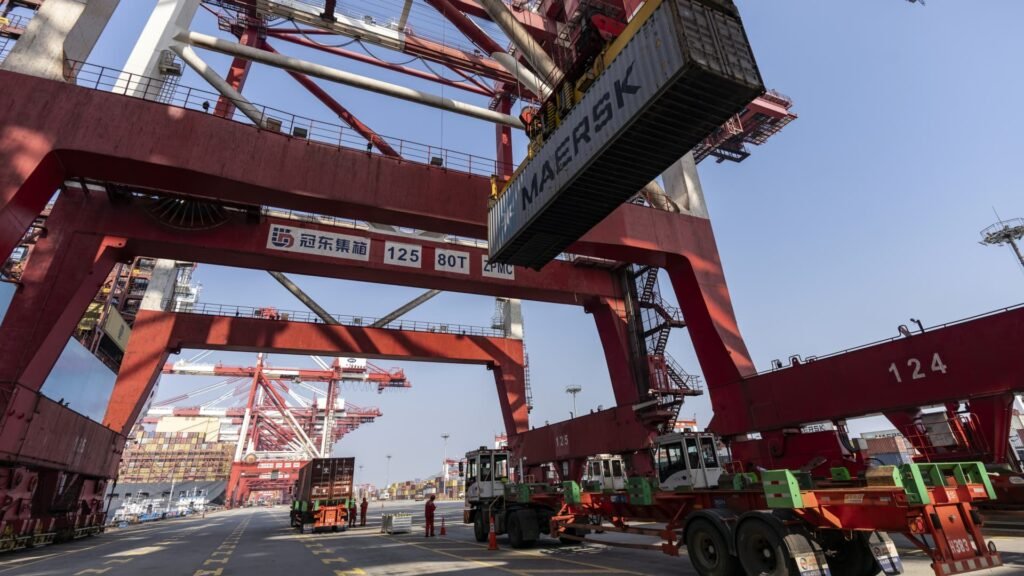Shipping containers and gantry cranes at Yangshan Deep Water Port in Shanghai, China, Thursday, October 10, 2024.
Bloomberg | Bloomberg | Getty Images
BEIJING — China’s imports and exports both fell short of expectations in September, raising concerns about one of the world’s second-largest economy’s few bright spots.
Exports rose 2.4% year-on-year in US dollar terms, while imports rose 0.3% in September, according to customs statistics released on Monday.
Analysts had expected growth to accelerate. According to a Reuters poll, China’s exports in September were expected to rise 6% year-on-year in US dollar terms, while imports were expected to rise 0.9% last month from a year earlier.
Exports are the main driving force for growth in China’s economy, but in recent years sluggish consumer spending and a real estate recession have weighed on the economy.
However, Zhiwei Zhang, president and chief economist at Pinpoint Asset Management, said in a note that rising trade tensions will make it difficult for China’s exports to continue growing at a high pace into next year. . “The change in fiscal policy stance outlined at the weekend’s press conference is critical as a pillar of growth next year.”
The United States and the European Union have increased tariffs on Chinese-made electric vehicles and other products.
China’s exports to the United States, its largest trading partner, rose 2.2% year-on-year in September, while imports from the United States rose 6.7%, according to a CNBC analysis of official data.
“Imports fell last month, but are likely to recover in the near term as accelerating fiscal stimulus boosts demand for industrial goods,” Capital Economics China economist Jichun Huang said in a note on Monday. said.
“We think [the finance ministry’s increase in fiscal expenditure will boost construction activity and drive higher demand for industrial commodities, at least for a quarter or two,” Huang said.
China’s Ministry of Finance had hinted at plans to increase the fiscal deficit on Saturday, without elaborating on the scale of such support at the time.
Exports to the Association of Southeast Asian Nations, China’s largest trading partner on a regional basis, rose by 5.5%, while imports climbed by 4.2%. China’s exports to the European Union edged 1.3% higher, while imports dropped by 4%.
China’s exports to BRICS partner Russia surged by 16.6%, but imports fell by 8.4%, the analysis showed.
Growth in China’s overall exports of autos slowed to a 25.7% year-on-year increase in September, while those of shoes, toys and smartphones all fell over the same period. Home appliances, integrated circuits and ships were among the categories that posted export growth.
In another sign of soft domestic demand, China’s crude oil imports dropped by 10.7% in U.S. dollar terms in September, compared with the same period of last year, while imports of natural gas and coal both climbed.
The latest data reflected Beijing’s efforts to bolster food supplies and access to rare earths, in order to ensure national security. China’s rare earths trade shrunk further, with exports plunging by more than 40% in September from a year ago, and imports down by around 9%.
Intake of soybeans, a major ingredient in livestock feed, surged by nearly 39%.
Lackluster demand
The data adds to a depressed picture of the Chinese economy, with the inflation print out Sunday pointing to further weakness in domestic demand.
The core consumer price index, which strips out more volatile food and energy prices, rose by 0.1% in September from a year ago. That’s the slowest since February 2021, according to the Wind Information database. Tourism-related prices fell by 2.1% year-on-year, despite the Mid-Autumn Festival in September and Golden Week holiday that kicked off Oct. 1.
China’s National Bureau of Statistics is scheduled to release third-quarter GDP data on Friday, along with retail sales, industrial production and fixed asset investment for September.
Chinese authorities have ramped up stimulus announcements since late last month, while so far falling short on the fiscal policy details many investors have hoped for. Stocks in China have swung wildly as beaten-down markets debate the ultimate impact of Beijing’s economic support.




